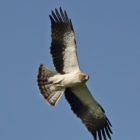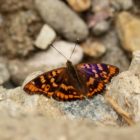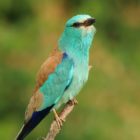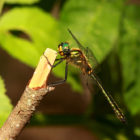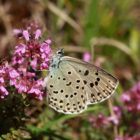Dates & Prices |
BOOK HOLIDAY NOW |
Dates: 9th – 16th June 2024 Confirmed departure
Price: £1,495 Places available
Single Room Supplement: £150
Deposit: £150 per person
Price Includes: All meals, accommodation, ground transport, services of guides + holiday report
Not Included: Flights, travel insurance, drinks and any other personal items
Conservation Donation: 10% of profits to a wildlife charity or project
Leader(s): Simeon Gigov (or another local guide) + second GW leader for groups of 6+
Group Size: Minimum of 4 and a maximum of 12 guests plus 1-2 leaders.
Grade: Gentle pace and generally short walks in a mix of terrains
Holiday Highlights
- Enjoy spring butterflies including Freyer’s Purple Emperor, Eastern Festoon, Assmann’s Fritillary, Grecian Copper, Russian Heath and Lattice Brown;
- Interesting dragonflies, such as Odalisque, Dark Spreadwing, Turkish Goldenring, Eastern Spectre and maybe even the extremely rare and endemic Bulgarian Emerald
- Great birding in various habitats with more than 150 species, including White Pelican, Eastern Imperial Eagle, Slender-billed Gull, Middle Spotted Woodpecker, Isabelline Wheatear, Eastern Orphean Warbler, Semi-collared Flycatcher, Sombre Tit and Masked Shrike
- Visit Strandzha Nature Park with its 50+ endemic plant species, some of which will be in flower
- Stay in the ancient seaside town of Sozopol in a nice hotel with excellent view towards the old town
- A one centre & slow pace tour, ideally suited to photography and full enjoyment of wildlife and scenery
We welcome you to explore with us the Southeastern part of Bulgaria with its very diverse habitats and rich flora and fauna. We’ll do it in a slow pace, which will give time to everyone to observe and photograph the wildlife of the area or just enjoy the beautiful sceneries. The Bourgas Region occupies the most southeastern corner of Bulgaria and holds big variety of habitats, flora and fauna that attracts thousands of nature-lovers each year. Encompassed between the Black Sea to the east, Balkan Mountain to the north, the Thracian Valley to the west and Strandzha Mountain to the south, the regions rewards its visitors with unspoiled habitats, rich biodiversity and lovely sceneries. Southeastern Bulgaria is one of the prime birding areas in Europe. Its big and shallow lakes are very rich on food and attracts thousands of waterfowl and waders. But what attract birders here are some of the SE Europe’s specialties like Eastern Imperial Eagle, Levant Sparrowhawk, Masked Shrike, Isabelline Wheatear, Olive-tree Warbler, Semi-collared Flycatcher, Sombre Tit, Black-headed Bunting. Nice and colorful species like European Bee-eater, European Roller, Eurasian Hoopoe and Golden Oriole are also very common here. We won’t miss to see the Great White and Dalmatian Pelicans too. June is excellent period to see and photograph butterflies and dragonflies in the area. The riverside meadows of Strandzha Nature Park are home to some rare species like Eastern Festoon, Grecian Copper, Freyer’s Purple Emperor, Assmann’s Fritillary and Russian Heath. In the oak forests we will look for Lattice Browns and if we get a bit lucky Large Chequered Skipper. The big wetlands in the area guarantee that the dragonflies will be very numerous, especially Dark Spreadwing, Lesser Emperor, Norfolk Hawker, White-tailed and Southern Skimmer and Scarlet Darter. But again Strandzha mountain is where most of the rare and most wanted species are: Bulgarian and Balkan Emerald, Turkish and Blue-eyed Goldenring, Eastern Spectre and Odalisque. The diversity of flora on this trip is guaranteed by the area’s geographical location. The combination of a coastal area with sand dunes and coastal lagoons and various types of forests in the mountains makes the botanical part of this holiday very special. The flora is an interesting mix of plants from further east such as Daphne pontica, Iris suaveolens and Fritillaria pontica. Local endemics such as the very strange Verbascum bugulifolium, Verbascum adrianopolitanum, Dianthus moesiacus, Knautia macedonica, Muscari vandasii, Genista rumelica and Carduus thracicus, a number of Salvias such as S. forskahlei and S. sclarea. Mediterranean type plants include examples of Cistus, Echium, Ophrys and Orchis species. Our only hotel during this trip will be situated in the ancient seaside town of Sozopol. The town was founded in the 7th century BC by Greek colonists and developed as one of the largest trade and naval Ancient Greek colonies in the Black Sea area. Nowadays the town is a major tourist area and has a well preserved old town, which we will visit in one of the afternoons of this trip. The Alepu and Arkutino marshes and Ropotamo Riverine Forest are situated not far from Sozopol, which are all protected areas and we will explore them during our pre-breakfast morning walks.




Day 1
Arrival at Bourgas Airport and transfer (~40 minutes) to Sozopol.
Day 2
Coastal аrea of Strandzha Nature Park
Morning transfer to one of the local nature reserves, which has been declared to preserve some of the most typical relict beech and oak forests in Strandzha Mnts, dominated by Eastern Beech (Fagus orientalis) and Oriental Durmast Oak (Quercus polycarpa) and evergreen bushes like Strandzhan Periwinkle (Rhododendron ponticum), Cherry Laurel (Prunus laurocerasus), Strandzhan Laurel (Daphne pontica) and Common Holly (Ilex aquifolium). Here we will be looking for Lesser Spotted Eagle, White-backed Woodpecker (ssp. lilfordii), Black Woodpecker, Middle Spotted Woodpecker, Semi-collared Flycatcher, Common Redstart (ssp. samamisicus) and Short-toed Treecreeper. Target species among the dragonflies will be Blue-eyed Goldenring and Odalisque.
After a picnic lunch we will visit the mouth of Veleka River and look for butterflies like Eastern Festoon, Ilex Hairstreak, Grecian Copper, Lang’s Short-tailed Blue and Large Chequered Skipper. Dragonflies in the area are represented by Scarce Emerald Damselfly, Scarce Blue-tailed Damsel, Small Red-eyed Damsel, Goblet-marked Damsel, Green-eyed Hooktail and Southern Skimmer. Flora of the area is represented by Astragalus spruneri, Blackstonia perfoliata, Calluna vulgaris, Calystegia sepium, Carduus thracicus, Carlina acanthifolia, Chamaecytisus jankae, Cistus salvifolius, Clematis recta, Cnicus benedictus, Consolida regalis, Daphne pontica, Echiusm plantagineum, Ephedra distachia, Erica arborea, Fritillaria pontica, Genista carinalis, Goniolimon collinum, Gratiolla officinalis, Heptaptera triquetra, Hymenocarpus circinatus, Hyoscyamus niger, Iris suaveolens, Lavatera thuringiaca, Merendera sobolifera, Orchis morio, Limodorum abortivum, Pastinaca hirsute, Pyracantha coccinea, Salvia forskahlei, Scilla bithynica, Verbascum adrianopolitanum, Verbascum bugulifolium, etc.
Day 3
Eastern Balkan Mountains in the morning. Pomorie Lake in the afternoon.
We will start the day in the foothills of the Eastern Balkan Mountains near Kableshkovo. The open oak forests of the area create excellent habitat for birds and we will look here for Middle Spotted Woodpecker, Lesser Spotted Woodpecker, European Bee-eater, Eastern Orphean Warbler, Eastern Boneli’s Warbler, Sombre Tit, Hawfinch and Cirl Bunting. Later we’ll climb up the mountain to an area with very old trees – home to Wryneck, Barred Warbler, Wood Lark, Sombre Tit, Ortolan Bunting, etc.
The afternoon we will spend around Pomorie Lake and Saltpans. Here we will look for Ruddy Shelduck, Black-winged Stilt, Collared Pratincole, Kentish Plover, Curlew Sandpiper, Gull-billed Tern, Slender-billed Gull, Mediterranean Gull, Little Gull and many other waders, ducks and terns. The lake is a breeding habitat of several species of dragonflies and especially abundant are the Dark Spreadwings, which are in millions along the reedbeds. Other species here are Lesser Emperor, White-tailed Skimmer, Southern Darter and Scarlet Darter.
Day 4
Karnobat hills in the morning and Atanasovsko Saltpans in the afternoon.
In years of big invasions the quarries in the area of Karnobat attract breeding Rose-coloured Starlings, which are a great spectacle to observe and also photograph. They breed in thousands and such congregations of course attract raptors like Peregrine Falcons, Eurasian Sparrowhawks and occasionally Saker Falcons. The quarries are also home of Eurasian Eagle Owl and Little Owl and in the steppe areas around we can also see Eastern Imperial Eagle, Booted Eagle, Montague’s Harrier, European Roller, Eurasian Hoopoe, Calandra Lark, Greater Short-toed Lark, etc. The area also hosts rich and diverse flora represented by Astragalus aitosensis, Alyssum tortuosum, Achillea depressa, Asperula cynanchica, Centaurea diffusa, Colutea arborescens, Euphorbia myrsinites, Fraxinus ornus, Jasminum fruticans, Minuartia setacea, Pyrus elaeagrifolia, Poa aitosensis, Stipa capillata, Trifolium leucanthum, Trigonella monspeliaca, Teucrium polium, Thymus striatus, etc.
The afternoon we will spend around Atanasovsko Lake and look for Dalmatian Pelican, Great White Pelican, Eurasian Spoonbill, Western Marsh Harrier, Pied Avocet, Black-winged Stilt, Eurasian Penduline Tit, Savi’s Warbler, Cetti’s Warbler and many other species of waders, gulls and terns. Of course dragonflies will also be in flight – Norfolk Hawker, Black-tailed Skimmer, White-tailed Skimmer, Scarce Chaser, Scarlet Darter, etc.
Day 5
Western Strandzha Mountains
Our main target here will be the Eastern Imperial Eagle. Other raptors that we can see here include the Lesser Spotted Eagle, Short-toed Eagle, Eurasian Honey Buzzard and Montague’s Harrier. In the oak forests and open habitats we will be searching also for the European Roller, Middle Spotted Woodpecker, Masked Shrike, Golden Oriole, Olive-tree Warbler, Eastern Boneli’s Warber, Semi-collared Flycatcher, Ortolan Bunting, Black-headed Bunting, etc. The area is very good for butterflies too – Purple-shot Copper, Mazarine Blue, Cardinal, Twin-spot Fritillary, Weaver’s Fritillary, Heath Fritillary, Assmann’s Fritillary and Russian Heath, as well as dragonflies like the Blue-eyed Goldenring.
Day 6
Mandra and Bourgas Lakes. Visiting Old Town Sozopol in the afternoon
It will be another day with many waterbirds to be seen and our targets among them will be DalmatianPelican, Great WhitePelican, Ferruginous Duck, Garganey, Black Stork, PurpleHeron, SquaccoHeron, LittleBittern, EuropeanHoneyBuzzard, White-tailed Eagle, Lesser Spotted Eagle, Booted Eagle, Woodchat Shrike, EurasianPendulineTit, Great Reed Warbler, OlivaceousWarbler, Golden Oriole, etc. Such vast wetland areas guarantee a lot of dragonflies too – Small Red-eyed Damsel, White-legged Damselfly, Lesser Emperor, Scarce Chaser, White-tailed Skimmer, Southern Skimmer and Scarlet Darter. Among the butterflies we will look for Eastern Festoon, Grecian Copper, Lattice Brown, Orbed Red-underwing Skipper, Oriental Marbled Skipper, etc.
Day 7
Strandzha Nature Park
Today we will spend the day in the heart of Strandzha Mountains in the area of the town of Malko Tarnovo. It will be our big dragonfly day and we will try to find the endemic Bulgarian Emerald, as well as Turkish Goldenring, Eastern Spectre, Balkan Emerald, Southern Migrant Hawker, Odalisque, Banded and Beautiful Demoiselles. Butterflies are also abundant here with Large Blue, Freyer’s Purple Emperor, Marbled Fritillary, Spotted Fritillary and Assmann’s Fritillary, being among the targets. The flora will be represented by Dianthus moesiacus, Digitalis lanata, Echium plantagineum, Epimedium pubigerum, Fritillaria pontica, Genista carinalis, Genista rumelica, Goniolimon colliunum, Hypericum calycinum, Iris suaveolens, Knautia ambigua, Knautia byzantina, Knautia macedonica, Lathyrus vernus, Laurocerasus officinalis, Mercurialis perennis, Muscari vandasii, Ophrys cornuta, Orchis papilionacea, Paeonia peregrina, Platanthera bifolia, Quercus hartwissiana, Rubus caesius, Salvia forskahlei, Salvia sclarea, Syringa vulgaris, Taxus baccata, Teucrium polium, Trachystemon orientalis, etc.
Day 8
Transfer to Bourgas Airport for departure.
New holiday so testimonials to follow.
New holiday so reports will follow later.


